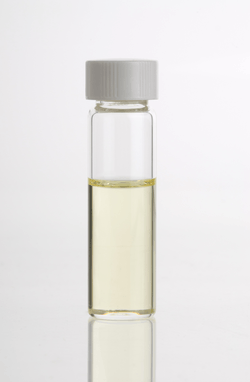Lavender oil

Lavender oil is an essential oil obtained by distillation from the flower spikes of certain species of lavender. Two forms are distinguished, lavender flower oil, a colorless oil, insoluble in water, having a density of 0.885 g/mL; and lavender spike oil, a distillate from the herb Lavandula latifolia, having density 0.905 g/mL. Like all essential oils, it is not a pure compound; it is a complex mixture of naturally occurring phytochemicals, including linalool and linalyl acetate. Kashmir Lavender oil is famous for being produced from lavender at the foothills of the Himalayas. As of 2011, the biggest lavender oil producer in the world is Bulgaria.[1]
Uses
Lavender oil has long been used in the production of perfume.[2]:184–186
In aromatherapy lavender oil produces a significant decrement in performance of working memory and impaired reaction times for both memory and attention based tasks compared to controls.[3]
Oil of spike lavender was used as a solvent in oil painting, mainly before the use of distilled turpentine became common.[4]
Research
Lavender oil has been found to potentiate GABAA receptor currents in vitro.[5][6] It has been found to have anxiolytic effects comparable to lorazepam in small clinical studies, which in animals were blocked by a 5-HT1A receptor antagonist but not by a GABAA receptor antagonist.[6][7][8] Lavender oil may be useful for alleviating anxiety and sleep disorders.[9][10][11][12][13] It also has antimicrobial, anti-inflammatory and mood alleviating effects.[14]
There are case reports of topical lavender oil administration producing prepubertal gynecomastia.[15][16] In vitro assessment with human cell lines found that lavender oil has estrogenic and antiandrogenic effects,[15] though an in vivo study with rats found no evidence of estrogenic activity at the doses assayed.[17] A small clinical study found that topical lavender oil in the form of an oil spray was effective in the treatment of young women with mild idiopathic hirsutism.[18]
Composition
The exact composition of lavender essential oil varies from species to species but consists primarily of monoterpeneoids and sesquiterpeneoids. Of these linalool and linalyl acetate dominate, with moderate levels of lavandulyl acetate, terpinen-4-ol and lavandulol. 1,8-cineole and camphor are also present in low to moderate qualities. In all lavender oil typically contains many more than 100 compounds, although a great many of these are present at very low concentrations.[19]
The composition of lavender essential oil as obtained by chromatography:
| Family | Composition | Lavande officinale Lavandula angustifolia |
Lavande aspic Lavandula latifolia |
|---|---|---|---|
| Terpenes / Monoterpenols |
 Linalool | 28.92 % | 49.47 % |
| α-Terpineol | 0.90% | 1.08% | |
| γ-Terpineol | 0.09% | ||
| Borneol | 1.43% | ||
| Isoborneol | 0.82% | ||
| Terpinen-4-ol | 4.32% | ||
| Nerol | 0.20% | ||
| Lavandulol | 0.78% | ||
| Terpenes / Terpene esters |
 | 32.98 % | |
| Geranyl acetate | 0.60% | ||
| Neryl acetate | 0.32% | ||
| Octene-3-yl acetate | 0.65% | ||
| Lavandulyl acetate | 4.52% | ||
| Terpenes / Monoterpenes |
Myrcene | 0.46% | 0.41% |
| α-Pinene | 0.54% | ||
| β-Pinene | 0.33% | ||
| Camphene | 0.30% | ||
| (E)-β-Ocimene | 3.09% | ||
| (Z)-β-Ocimene | 4.44% | ||
| β-Phellandrene | 0.12% | ||
| Terpenes / Terpenoid oxides |
 Eucalyptol (1,8-cineol) | 25.91 % | |
| Terpenes / Sesquiterpenes |
β-Caryophyllene | 4.62% | 2.10% |
| β-Farnesene | 2.73% | ||
| Germacrene | 0.27% | ||
| α-Humulene | 0.28% | ||
| Ketones |  Camphor |
0.85% | 13.00 % |
| 3-Octanone | 0.72% | ||
| Cryptone | 0.35% |
See also
References
- ↑ Bulgarian lavender producers worried about demand drop, China Post, 14 July 2011
- ↑ N. Groom. New Perfume Handbook. Springer Science & Business Media, 1997 ISBN 9780751404036
- ↑ Mark Moss; Jenny Cook; Keith Wesnes; PAUL Duckett (2003). "Aromas of rosemary and lavender essential oils differentially affect cognition and mood in healthy adults". International Journal of Neuroscience. 113 (1): 15–38. doi:10.1080/00207450390161903. PMID 12690999.
- ↑ "Solvent", pp 605-606 in The Grove Encyclopedia of Materials and Techniques in Art, edited by Gerald W. R. Ward. Oxford University Press, 2008 ISBN 9780195313918
- ↑ Huang, Liping; Abuhamdah, Sawsan; Howes, Melanie-Jayne R.; Dixon, Christine L.; Elliot, Mark S. J.; Ballard, Clive; Holmes, Clive; Burns, Alistair; Perry, Elaine K.; Francis, Paul T.; Lees, George; Chazot, Paul L. (2008). "Pharmacological profile of essential oils derived from Lavandula angustifolia and Melissa officinalis with anti-agitation properties: focus on ligand-gated channels". Journal of Pharmacy and Pharmacology. 60 (11): 1515–1522. doi:10.1211/jpp.60.11.0013. ISSN 0022-3573.
- 1 2 Chioca, Lea R.; Ferro, Marcelo M.; Baretta, Irinéia P.; Oliveira, Sara M.; Silva, Cássia R.; Ferreira, Juliano; Losso, Estela M.; Andreatini, Roberto (2013). "Anxiolytic-like effect of lavender essential oil inhalation in mice: Participation of serotonergic but not GABAA/benzodiazepine neurotransmission". Journal of Ethnopharmacology. 147 (2): 412–418. doi:10.1016/j.jep.2013.03.028. ISSN 0378-8741.
- ↑ Silvia Laura Guzmán-Gutiérrez; Herlinda Bonilla-Jaime; Rocío Gómez-Cansino; Ricardo Reyes-Chilpa (May 2015). "Linalool and β-pinene exert their antidepressant-like activity through the monoaminergic pathway". Life Sciences. 128: 24–29. doi:10.1016/j.lfs.2015.02.021. PMID 25771248.
- ↑ Pia Baldinger; Anna S. Höflich; Markus Mitterhauser; Andreas Hahn; Christina Rami-Mark; Marie Spies; Wolfgang Wadsak; Rupert Lanzenberger; Siegfried Kasper (February 2015). "Effects of Silexan on the Serotonin-1A Receptor and Microstructure of the Human Brain: A Randomized, Placebo-Controlled, Double-Blind, Cross-Over Study with Molecular and Structural Neuroimaging". International Journal of Neuropsychopharmacology. 18 (4). doi:10.1093/ijnp/pyu063. PMC 4360214
 . PMID 25522403.
. PMID 25522403. - ↑ Kasper S (2013). "An orally administered lavandula oil preparation (Silexan) for anxiety disorder and related conditions: an evidence based review". Int J Psychiatry Clin Pract (Review). 17 Suppl 1: 15–22. doi:10.3109/13651501.2013.813555. PMID 23808618.
- ↑ Siegfried Kasper; Hans-Peter Volz; Angelika Dienel; Sandra Schläfke (December 2015). "Efficacy of Silexan in mixed anxiety–depression – A randomized, placebo-controlled trial". European Neuropsychopharmacology. doi:10.1016/j.euroneuro.2015.12.002. PMID 26718792.
- ↑ Siegfried Kasper; Markus Gastpar; Walter E Müller; Hans-Peter Volz; Hans-Jürgen Möller; Sandra Schläfke; Angelika Dienel (June 2014). "Lavender oil preparation Silexan is effective in generalized anxiety disorder – a randomized, double-blind comparison to placebo and paroxetine". International Journal of Neuropsychopharmacology. 17 (6): 859–869. doi:10.1017/S1461145714000017. PMID 24456909.
- ↑ H. Woelk; S. Schläfke (February 2010). "A multi-center, double-blind, randomised study of the Lavender oil preparation Silexan in comparison to Lorazepam for generalized anxiety disorder". Phytomedicine. 17 (2): 94–99. doi:10.1016/j.phymed.2009.10.006. PMID 19962288.
- ↑ Siegfried Kasper; Markus Gastpar; Walter E. Müller; Hans-Peter Volz; Hans-Jürgen Möller; Angelika Dienel; Sandra Schläfke (September 2010). "Silexan, an orally administered Lavandula oil preparation, is effective in the treatment of 'subsyndromal' anxiety disorder: a randomized, double-blind, placebo controlled trial". International Clinical Psychopharmacology:. 25 (5): 277–287. doi:10.1097/YIC.0b013e32833b3242. PMID 20512042.
- ↑ Johanna M. Gostner; Markus Ganzera; Kathrin Becker; Simon Geisler; Sebastian Schroecksnadel; Florian Überall; Harald Schennach; Dietmar Fuchs (December 2014). "Lavender oil suppresses indoleamine 2,3-dioxygenase activity in human PBMC". BMC Complementary and Alternative Medicine. 14 (503). doi:10.1186/1472-6882-14-503. PMC 4301885
 . PMID 25515049.
. PMID 25515049. - 1 2 Henley, Derek V.; Lipson, Natasha; Korach, Kenneth S.; Bloch, Clifford A. (2007). "Prepubertal Gynecomastia Linked to Lavender and Tea Tree Oils". New England Journal of Medicine. 356 (5): 479–485. doi:10.1056/NEJMoa064725. ISSN 0028-4793.
- ↑ Henley DV, Korach KS (July 2010). "Physiological effects and mechanisms of action of endocrine disrupting chemicals that alter estrogen signaling". Hormones. 9 (3): 191–205. doi:10.14310/horm.2002.1270. PMID 20688617.
- ↑ Politano, V. T.; McGinty, D.; Lewis, E. M.; Hoberman, A. M.; Christian, M. S.; Diener, R. M.; Api, A. M. (2013). "Uterotrophic Assay of Percutaneous Lavender Oil in Immature Female Rats". International Journal of Toxicology. 32 (2): 123–129. doi:10.1177/1091581812472209. ISSN 1091-5818.
- ↑ Tirabassi G, Giovannini L, Paggi F, Panin G, Panin F, Papa R, Boscaro M, Balercia G (2013). "Possible efficacy of Lavender and Tea tree oils in the treatment of young women affected by mild idiopathic hirsutism". J. Endocrinol. Invest. 36 (1): 50–4. doi:10.3275/8766. PMID 23211454.
- ↑ Shellie, Robert; Mondello, Luigi; Marriott, Philip; Dugo, Giovanni (2002). "Characterisation of lavender essential oils by using gas chromatography–mass spectrometry with correlation of linear retention indices and comparison with comprehensive two-dimensional gas chromatography". Journal of Chromatography A. 970 (1-2): 225–234. doi:10.1016/S0021-9673(02)00653-2. ISSN 0021-9673.